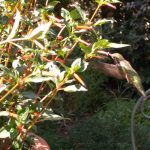 What a glorious spring! Having been blessed with generous snow and rain, the land is bursting with energy, greener than green, and flowering in kaleidoscopic exuberance! Migratory birds have been arriving or passing though our region this month, offering sightings of avian treasures like Lazuli Buntings and Western Tanagers, not to mention the hummingbirds. We do live in a wondrous world!
What a glorious spring! Having been blessed with generous snow and rain, the land is bursting with energy, greener than green, and flowering in kaleidoscopic exuberance! Migratory birds have been arriving or passing though our region this month, offering sightings of avian treasures like Lazuli Buntings and Western Tanagers, not to mention the hummingbirds. We do live in a wondrous world!
THE VEGETABLE REPORT
It’s prime time for summer vegetable planting; when the soil warms up and night temperatures stay above 50 degrees Fahrenheit in late May and early June, it’s time to transplant starts of Tomato, Pepper, Eggplant, and Tomatillo, as well as Cucumber, Melon, Zucchini, Summer and Winter Squash, Watermelon, Pumpkin and Basil. And our propagators keep bringing us more!

Hablitzia tamnoides, Perennial Spinach Vine
We also encourage you to try Munich Purslane, much larger than our local ‘weed’ purslane, and the only vegetable high in healthy Omega-3 essential fatty acids that is super-easy to grow at home! Use it in salads, pickles and soups! Later in the season, you can let it self-sow to give you a free crop next year. And as we write, we are receiving another half flat of Perennial Spinach vine (Hablitzia tamnoides), an incredible, hardy, shade-loving, long-lived and fast-growing perennial in the same family as spinach, which will keep you in fresh, nutritious greens for many weeks!
We received an excellent guide to growing peppers from our friend and expert grower/farmer Frank Hodge (Father Earth Farm), quoted here:
The warmer it is, the better peppers like it. I find it best to start seeds indoors around the middle of April and transplant the seedlings into your outside garden the end of May or first part of June … But what we gardeners have in mind as “good and warmed up”, is not the same as what the pepper plant is thinking … or feeling. There are not many vegetable plants that are as nit-picky about soil temperature as pepper plants. The number one thing to remember about peppers is that they WILL NOT grow, not even an inch in three weeks if the nighttime soil temperature is less than 55 degrees. Even if the daytime temps are 70, 80. or 90 degrees, if the night temps drop below 55, the plant will sit there waiting for that “55-degree go-ahead and start growing” signal.
I would suggest getting a soil thermometer to help you decide when to transplant. You can use black plastic, black weed barrier, or even Wall-o-water [or Solar Caps, pictured left] to warm the soil before transplanting, but you will have to use these same methods to keep the soil warm after transplanting until about the end of June here in Colorado. Row cover works well to help keep the plants and ground warmer at night and can be left on until the plants begin to flower.
Peppers don’t seem to like their roots wet all the time, so deep watering a couple times a week should work in most soils, allowing the plant to dry out slightly between waterings. Pepper plants are a member of the nightshade family, and like tomatoes, they are NOT pollinated by honeybees. They rely on the wind and native pollinators for pollination. I suggest that you not rely on the wind, but “hand pollinate” by shaking the plant as you would a tomato plant or purchase a plant vibrator/pollinator. Pollination is best done daily in the afternoon or evening when the pollen in the flowers is dryer from the effects of morning dew.
VEGGIES FROM SEED:
Warm soils also signal that it is time to direct-sow many classic summer vegetables and herbs, and we have plenty of seeds to offer:
 Corn
Corn
Beans
Summer & Winter Squash
Cucumber
Melon
Watermelon
Pumpkin
Carrots (can be seeded throughout June for a fall harvest)
Johnny’s Select Seeds offers wonderful, detailed growing instructions for farmers and home gardeners, and we highly recommend you save and read their article ‘Beat the Heat: Cultural Practices to Get Your Crops through the Summer Heat, parts 1 & 2’.
SUMMER FLOWERS FROM SEED
Many classic summer flowers are sown directly in the garden at this time of year, including:
Zinnia
Sunflower
Mexican Sunflower (Tithonia)
 Morning Glory
Morning Glory
Nasturtium
Marigold
Sunrose
Scarlet Runner Bean
Mina lobata
Four O’Clock
Flowering Tobacco
Snapdragon
and more!
ANNUAL FLOWERS STARTS
We also have starter plants of many wonderful Annual Flowers for garden beds and containers:

Cuphea ignea Coan Scarlet with hummingbird
Black-eyed-Susan Vine (Thunbergia alata)
Spanish Flag vine (Mina lobata)
Zinnia State Fair, Cut & Come Again, Oklahoma White
Snapdragon ‘Black Prince’ & ‘Appleblossom’
Cigar Pant (Cuphea) – 3 great varieties, hummingbird magnet!
Begonias
Impatiens
Datura – native Angel’s Trumpet, and double-flowered Ballerina Mix
Marigold (6 varieties!)
Woodland Flowering Tobacco
Pheasant’s Eye (Adonis aestivalis)
Bachelor Button, blue
Honeywort (Cerinthe major) for beauty and the bees!

Scarlet Peony Poppy
Verbena bonariensis, Homestead Purple and Red Devil
Petunia – Brazilian Red and Balcony Mix
Salvia – Blue Monday, Scarlet, Mojave Red – for hummers!
Lobelia ‘Crystal Palace’
Swan River Daisy (Brachycome)
Scarlet Peony Poppy
and more!
